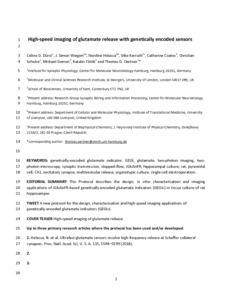Dürst, CD; Wiegert, JS; Helassa, N; Kerruth, S; Coates, C; Schulze, C; Geeves, MA; Török, K; Oertner, TG
(2019)
High-speed imaging of glutamate release with genetically encoded sensors.
Nat Protoc, 14 (5).
pp. 1401-1424.
ISSN 1750-2799
https://doi.org/10.1038/s41596-019-0143-9
SGUL Authors: Torok, Katalin
![[img]](https://openaccess.sgul.ac.uk/111254/1.hassmallThumbnailVersion/11334_2_merged_1547205759.pdf)  Preview |
|
PDF
Accepted Version
Available under License ["licenses_description_publisher" not defined].
Download (4MB)
| Preview
|
Abstract
The strength of an excitatory synapse depends on its ability to release glutamate and on the density of postsynaptic receptors. Genetically encoded glutamate indicators (GEGIs) allow eavesdropping on synaptic transmission at the level of cleft glutamate to investigate properties of the release machinery in detail. Based on the sensor iGluSnFR, we recently developed accelerated versions of GEGIs that allow investigation of synaptic release during 100-Hz trains. Here, we describe the detailed procedures for design and characterization of fast iGluSnFR variants in vitro, transfection of pyramidal cells in organotypic hippocampal cultures, and imaging of evoked glutamate transients with two-photon laser-scanning microscopy. As the released glutamate spreads from a point source-the fusing vesicle-it is possible to localize the vesicle fusion site with a precision exceeding the optical resolution of the microscope. By using a spiral scan path, the temporal resolution can be increased to 1 kHz to capture the peak amplitude of fast iGluSnFR transients. The typical time frame for these experiments is 30 min per synapse.
| Item Type: |
Article
|
| Additional Information: |
This is a post-peer-review, pre-copyedit version of an article published in Nature Protocols. The final authenticated version is available online at: http://dx.doi.org/10.1038/s41596-019-0143-9 |
| Keywords: |
Biosensing Techniques, CA3 Region, Hippocampal, Cells, Cultured, Glutamic Acid, Humans, Microscopy, Confocal, Molecular Probes, Optical Imaging, Synaptic Transmission, Transfection, Cells, Cultured, Humans, Glutamic Acid, Molecular Probes, Microscopy, Confocal, Transfection, Biosensing Techniques, Synaptic Transmission, CA3 Region, Hippocampal, Optical Imaging, 06 Biological Sciences, 11 Medical And Health Sciences, 03 Chemical Sciences, Bioinformatics |
| SGUL Research Institute / Research Centre: |
Academic Structure > Molecular and Clinical Sciences Research Institute (MCS) |
| Journal or Publication Title: |
Nat Protoc |
| ISSN: |
1750-2799 |
| Language: |
eng |
| Publisher License: |
Publisher's own licence |
| Projects: |
|
| PubMed ID: |
30988508 |
| Web of Science ID: |
WOS:000468031200004 |
 |
Go to PubMed abstract |
| URI: |
https://openaccess.sgul.ac.uk/id/eprint/111254 |
| Publisher's version: |
https://doi.org/10.1038/s41596-019-0143-9 |
Statistics
Item downloaded times since 03 Oct 2019.
Actions (login required)
 |
Edit Item |



